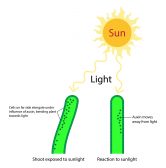Definition
noun
The final stage of prophase I of meiosis I in which the chromosomes condense, the nucleolus fragments and the nuclear envelope disperse
Supplement
Meiosis is form of cell division that gives rise to genetically diverse sex cells or gametes. It is comprised to two successive nuclear divisions namely meiosis I and meiosis II. Meiosis I is comprised of four stages: prophase I, metaphase I, anaphase I, and telophase I. Prophase I is the first stage and consists of the following sub-stages: leptotene, zygotene, pachytene, diplotene and diakinesis.
Diakinesis is the final stage of prophase I. In human and other mammalian ootidogenesis, the cell (i.e. primary oocyte) is in the arrested state (called dictyate) prior to diakinesis. The rest of the stages of meiosis resumes by the time of puberty. Diakinesis is highlighted by further chromosome condensation, disintegration of the nuclear envelope into vesicles, and the seemingly disappearance of the nucleolus. The four chromatids as well as the chiasmata are now more clearly visible at this point. Meiotic spindle fibers also start to form in preparation for the next stage of meiosis I, the metaphase I.
Word origin: Greek dia (“through”) + kinēsis (movement)
See also:
- meiosis
- meiosis I
- prophase I
- leptotene
- zygotene
- pachytene
- diplotene
- homologous chromosome
- dictyate
- metaphase I







